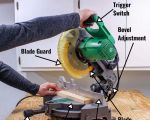- 1-Understanding-Extension-Ladders-and-Their-Uses
- 2-Determining-the-Right-Ladder-Length-for-Your-Project
- 3-Choosing-Materials-and-Build-Quality
- 4-Assessing-Weight-Capacity-and-Duty-Ratings
- 5-Safety-Features-to-Consider
- 6-Real-Life-Case-Study-Choosing-the-Right-Ladder
- 7-Where-to-Find-the-Best-Extension-Ladders-ToolNest
1. Understanding Extension Ladders and Their Uses
Extension ladders are versatile tools designed to reach high places, making them indispensable for various projects such as home maintenance, construction, painting, or tree trimming. Knowing how to choose the right extension ladder for your project starts with understanding the types available and their ideal applications.
Extension ladders typically consist of two or more sections that slide and lock to adjust length, providing flexibility. Selecting the correct type based on project needs ensures efficiency and safety.
1.1 Common Applications of Extension Ladders
Extension ladders excel in tasks requiring height reach beyond fixed ladders. From cleaning gutters to roofing repairs, choosing a ladder suited to your specific use is vital for comfort and stability.
2. Determining the Right Ladder Length for Your Project
One of the first steps in choosing an extension ladder is determining the appropriate length. Consider the height of the work area and add extra length for safe positioning. A general rule is the ladder should extend at least three feet above the landing point to provide secure handholds.
For example, if you need to reach a roof edge 20 feet high, selecting a ladder that extends to at least 23 feet is prudent. This calculation prevents dangerous overreaching and ensures the ladder's stability.
3. Choosing Materials and Build Quality
Extension ladders come in several materials including aluminum, fiberglass, and wood. Aluminum ladders are lightweight and resistant to rust but conduct electricity, which can be hazardous near power lines. Fiberglass ladders offer excellent durability and electrical insulation, preferred by electricians and professional contractors.
Wood ladders, though traditional, require more maintenance and are less common for heavy-duty projects. Evaluating build quality, including rung design and locking mechanisms, influences safety and user experience.
4. Assessing Weight Capacity and Duty Ratings
Understanding weight capacity is critical when selecting your extension ladder. Ladders have duty ratings that specify the maximum load they can safely support, including the user's weight and any tools or materials carried.
Common duty ratings include Type III (light duty), Type II (medium duty), Type I (heavy duty), and Type IA or IAA (extra heavy duty). For most home and professional projects, selecting at least a Type I or IA ladder ensures safety and durability.
5. Safety Features to Consider
Safety should be a top priority when choosing an extension ladder. Features such as slip-resistant feet, secure locking mechanisms, stabilizer bars, and clear labeling enhance safe use.
Additional considerations include ease of transport, storage, and user-friendly adjustment systems that allow smooth extension and retraction.
6. Real-Life Case Study: Choosing the Right Ladder
John, a homeowner tackling a roof repair, initially bought an aluminum ladder that was too short and lacked stability. After consulting experts and reviewing safety guidelines, he upgraded to a 24-foot fiberglass ladder with a Type IA rating from ToolNest. This decision improved his safety and efficiency dramatically, underscoring the importance of informed ladder selection.
7. Where to Find the Best Extension Ladders: ToolNest
For the best selection of extension ladders tailored to your project, ToolNest offers expertly curated options with detailed product information and customer reviews. Their platform provides guidance on choosing ladders based on your specific needs, safety features, and budget.
Visit ToolNest to explore a wide range of ladders and accessories, ensuring you select the right extension ladder that guarantees safety, durability, and convenience for every project.









